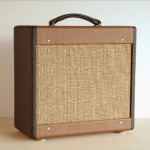Home › Forums › Design and Building › 2 Stroke Amplifier Design and Building › 2 Stroke component question..
- This topic has 6 replies, 3 voices, and was last updated June 7, 2020 at 11:41 pm by
Brent.
-
AuthorPosts
-
February 14, 2020 at 3:32 pm #8266
Brent
ParticipantHello All,
Recently joined the forum here as I am considering a Two-Stroke type build. In looking at the schematic and comparing images I see that there is what appears to be an additional high watt resistor on some builds including that in Dave’s book. I have searched around a little but have not located any mention of this in other discussions. Forgive me in advance if I missed it. Just wondering what the intended purpose(screen resistor?)was.Thanks
Attachments:
February 14, 2020 at 4:00 pm #8270Andy
KeymasterHi Brent!
Welcome to the site! If you do go with this build, you will love it. It is a simple amp but has a pretty complex and unique sound to it. I love that you can build it such that you can swap the power tubes and that makes a cool way to really hear the different tube differences. I settled on a big bottle KT66 personally 😉
As far as the 5W and 10W resistors, folks put them in different places based on preference and board layout. Most of the time, folks building for the first time use the two positions that Dave suggests in his book.
The 10K 5W comes right off the rectifier tube. That is part of the voltage filtering/power reduction network in the power supply. This looks like what you are pointing to.
The other 500Ω 10W (next to the one you indicated) comes off the cathode of the power tube. That is part of the biasing network, its a cathode bypass capacitor. Here is some info on that: Cathode Bypass Capacitor
It looks like the pictures are wired like the diagrams and schematic provided by the book and that are on this site. Hard to see the value of the resistor you indicated but it seems right.
I think thats what you are asking?
February 14, 2020 at 5:48 pm #8271Brent
ParticipantThanks for the reply Andy,
I do see what you are saying but my confusion is this. The builds in the images appear to already have a 10k and 68k between the nodes on the filter capacitors as shown in the schematic. Unless one is bypassed it would seem as though there is one extra 10k resistor.
February 14, 2020 at 8:12 pm #8272Andy
KeymasterHey Brent,
Its pretty hard to see what they are doing there or why. It looks like the Weber Maggie version does something similar: Weber Maggie.
It looks like it might be knocking down the power coming out of the rectifier a bit and doing a bit of filtering depending if the value is the same as on the Maggie. I’d need to throw it on the modeler to see if it makes an appreciable performance difference. Our two strokes perform pretty well without that.
If Robin is still around he might have some insight.
February 15, 2020 at 12:50 am #8273Brent
ParticipantThanks,
It’s hard for me to determine the value of each from the photos, I suppose they could be different from the schematic.There is a minimum of space for that 10k between filter caps so maybe they moved/combined those to utilize a larger wattage resistor. I’m pretty sure that Fender used a 10k 1 watt carbon comp but that was with the 6V6 and probably got baked fairly often. Thanks again for the information, I’m looking forward to building one in the near future.
June 6, 2020 at 12:08 am #8360 RobinParticipant
RobinParticipantI can’t tell from the component board because the leads are on the back but it looks like it goes to the power tube socket as the cathode bias resistor, bypassed by that cap next to it. All my 2Strokes have a 500r/ 10w resistor bypassed with a 25uf/ 50v cap. The attached photo shows my very first 2Stroke layout, it works great.
Attachments:
June 7, 2020 at 11:41 pm #8362Brent
ParticipantYeah I see what looks to be the cathode resistor and bypass cap but that resistor looks to be something in addition. That amp looks use the Ohmite 500ohm/10w resistor with the capacitor kind of hidden next to the first filter cap. Just caught my eye as odd but do like the 5881!
-
AuthorPosts
- You must be logged in to reply to this topic.



